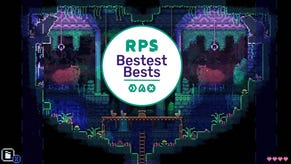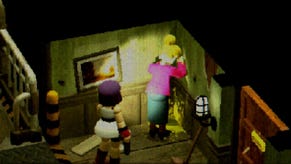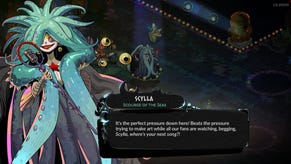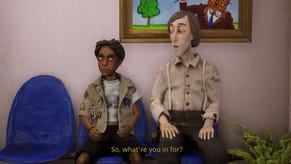Wot I Think - StarCraft II: Legacy Of The Void Singleplayer
Devoid of humanity
StarCraft II: Legacy of the Void [official site] is the second expansion for StarCraft II, this time focused on mystical, mouthless, paladin-like alien race the Protoss. I'm not much of a one for StarCraft II multiplayer, but I wanted to see the singleplayer tale through to its conclusion and, heck, I do miss traditional real-time-strategy, so I took a belated look at the campaign mode.
When your entire cast consists of people who don't have mouths or pupils, you need to do your damnedest to ensure their words carry the emotion their faces cannot. Legacy of the Void does not do that. In fact, it does the exact opposite of that.
The StarCraft II series before Legacy of the Void wouldn't win any storytelling awards in a sane universe, but at least it tried to give its main cast personalities. Those personalities are hilariously broad - hard-bitten space cowboy with a heart of gold, vengeful death-queen, snooty evil emperor - but at least you knew who they were, and what they cared about.
This third and ostensibly final part of the StarCraft II series has already been wrong-footed by its two predecessors wrapping up the bulk of the storyline, making it all the more bewildering that it doesn't even try to imbue its cast of mouthless Protoss techno-aliens (whose goal is overcome some evil deity who's trying to crossbreed them with Zerg and then destroy the universe or something) with any semblance of a personality.
Every one of them speaks robotically faux-biblical lines like "and in that treasonous instant, Adun ushered the heretics and himself unto fate", like a whole cast of entirely humourless Thors. None have anyone they care about, or mourn for, or hope for. Great, OK, they want to save their race from a returned dark god who wants to do that thing that returned dark gods always want to do, but they don't have any personal stakes. Or, for that matter, characteristics beyond "very serious".
This is a tale without anyone or anything to anchor to unless you're really, really into cement-faced aliens who sound like they've never smiled in their lives and are for some reason trying out for a part at the Renaissance fair. Even the overblown pulp and soap operatic pomp of the last two instalments is lost in favour of a relentless tidal wave of bone-dry exposition and techno-babble.
Nobody in the Protoss cast makes an individual impression. I'm not even sure I can tell you anyone's names: they are all the same person with a different skin. Even the one who's a robot. It was a genuine relief when StarCraft old hands Kerrigan and Raynor made their appearances, no matter how contrived or redundant after the events of earlier chapters, because at least they and their doomed, chaste courtship represent something human, something beyond technobabble incarnate.
Rest assured it reaches a definite conclusion, but the vast bulk of it is so cloyingly dour, so entirely devoid of wit, warmth or humanity. It's the kind of videogame storytelling that would cause someone who doesn't play videogames to decide, should they walk in on me playing it, that this really is the lowest common denominator of art forms. It's not simply tedious: it's openly humiliating that one of the biggest game-makers in the world believe that all we want is this. I'd be highly tempted to say that this was Blizzard on cruise control, including a token singleplayer effort for a package only really intended for its multiplayer mode. And yet they have, as always, clearly spent an absolute shit-ton of money on cinematics and setpiece levels. This is them being as big as they can be.
Nothing in it is an accident; nothing is the result of laziness or inability. Quite the opposite. This is laser-targeted, mathematically-calculated offal, meeting the believed needs of an audience obsessed with lore above all else. It's a formula that has worked many times for Blizzard before, but Legacy of the Void is that formula at its most depressing, its most inhuman. Everything but made-up words and hollow bombast has been scoured away. In the grim darkness of twenty-first century blockbuster videogaming, there is only lore.
And breathe. Breathe. Done with story now. Time to talk about the real-time strategy missions that are squeezed inside the inanity. And they're pretty good stuff, if by now fairly familiar. Legacy of the Void works hard to make each level distinct from the last, and indeed to make each an escalation upon the last one. Blizzard have very much mastered the indefinite crescendo, each challenge feeling even more impossibly climactic than the last.
We're a long, long way from the routine military ops of the original StarCraft and deep into some ongoing intergalactic apocalypse, so there's almost always some race against time element, and some giant doohickey that needs to be defended or destroyed. It's very good at sending absurd waves of enemies at you, convincing you that the situation is unwinnable, in order that you then feel like the champion of champions when you do, in fact, win.
It's admirably unafraid to be difficult, though. This far into the series, it accepts that even the most casual SC2 player knows how all this stuff works. Despite a few early attempts to teach higher-level tactics, it quickly gives up on that and ramps up the challenge. I'm happy with that. I'm unlikely to go anywhere near multiplayer StarCraft again - primarily because it's a lifestyle rather than something you dip occasional toes into - but that doesn't mean I want to be shown the ropes every time I dabble in campaigns which, with the best will in the world, are fundamentally only doing what RTS campaigns have been doing for three decades.
Give me a stiff challenge with lots of moving parts and let me hack away at it in my own time, at my own pace: Legacy of the Void does that. Almost every level has the structure, pacing and intensity of the final mission in any other RTS. I might hate the trappings around it, but I do admire that. It kept me busy, and maintains that element of army-building choice that the last two instalments offered. I'm picking unit variations and global powers that suit my style rather than just being granted access to set functions as the campaign dictates. The Protoss as a whole have some neatly counter-intuitive tricks which force me to think about strategy, not simply resort to build'n'bash. I might not care for their characters, but on a tactically level, they're hugely interesting.
At the same time, mission-to-mission, it does tend to feel very similar, because no matter how many setpiece enemy swarms or mega-monsters it throws at us it's still bound by StarCraft II's core multiplayer rules. It doesn't help that the blue colour scheme of the Protoss has such a homogenising effect either. The gigantic, apocalyptic spectacle of each mission sits somewhat at odds with the routine busy-work of building workers and queuing upgrades, especially when the cutscenes invariably show that the guys you're playing as have the ability to mass-transport gazillions of troops wherever they please. Er. Why not just beam everyone down to deal with the thingy in the temple of wotsit rather than have me laboriously build an army then? But, for the sake of sanity, it is best to separate cutscene logic from mission logic.
The campaign is not particularly long, but its intensity is such that it would be hard to argue you were short-changed. It makes the stage as wide as it can, so a mission is something that leaves you satisfyingly fatigued rather than just a step to sprint up en route to the next. While clearly techno-magician aliens the Protoss are centre stage, the Terrans and Zerg (and their main characters) get a few new moments in the sun too, plus missions hop between massed armies and all-conquering hero affairs. Every trick in trad. RTS' box is deployed, and with more gloss and varnish than anyone else could possibly muster.
It doesn't have the cleanness or the slow-burn escalation of your old-school C&Cs or the first Warcrafts and StarCraft, so certainly don't approach it as a return to the old ways, but if you want a giant sci-fi army bashing buildings and monsters to death while a crazy lightshow rages, Legacy of the Void is hard to argue with on that basis.
What I personally would like to see from any future StarCraft or Warcraft, if they are to have a singleplayer future, is to now dial it back a bit. When the stakes are sky-high from the get-go, and when every character can survive any cataclysm until arbitrary plotting decides otherwise, there's no drama to be had, little sense of achievement to be found. Of course, this is intended to be the third and probably final act of a larger game, but even so, it's kicking off from a cold start, several years after the last one. Give me a reason to care before you make everything explode.















